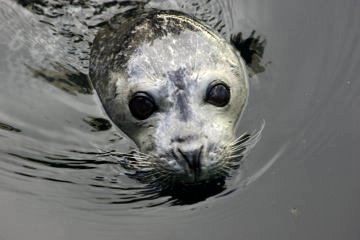Has Early Programming Sealed These Animals’ Fate?
For the past quarter century, populations of harbor seals in parts of Alaska have fallen precipitously. In 1980, for instance, perhaps 1,600 seals roamed within the glacial waters of the Gulf of Alaska’s Aialik Bay. Today, only some 200 of the marine mammals can be found there. Some researchers in that area now believe they may have stumbled onto a key to the animals’ vulnerability: poor early nutrition.



Two years ago, researchers with the Alaska SeaLife Center in Seward captured four newly weaned, month-old pups. Last year, the researchers collected another four of the bullet-shaped youngsters. All will be studied at the center for the rest of their lives—perhaps another 25 years.
At capture, the young harbor seals (Phoca vitulina) weighed 21 to 33 kilograms (9.5 to 15 pounds). All were assigned a robust diet of protein-rich pollack, squid, and capelin. These fish typically contain less than 4 percent fat. In addition, each seal was fed oilier herring with one of two proportions of fat. Half of the animals captured each year got herring containing about 6 percent fat, while the other half received herring with a whopping 15 percent fat.
The researchers assigned both small and large pups to each group. One part of the study was to test whether dietary fat affected how well runts might catch up to larger seals. The scientists also wanted to see whether pudgy pups getting the low-fat fare would slim down. Overall, the high-fat diet delivered about 15 percent more calories.
Although the researchers expected the animals getting high-fat diets to grow about 15 percent faster, it hasn’t worked out that way, which was “quite a surprise,” notes team leader Lori Polasek, a marine mammal physiologist. Essentially, the biggest pups have remained the biggest youths, even when assigned to the low-fat herring. Runts have continued to be runts, she says, “struggling to put on weight and grow, regardless of their diet.” Those who started in between these extremes have grown steadily at a middling rate.
In other words, Polasek reported in April at a meeting of the American Physiological Society in San Francisco, the seals’ metabolism appears to have been programmed prior to weaning.
That’s troubling, she says, because it suggests that pups reared in years when food supplies are limited may fight their whole life to build up the energy stores of blubber that can sustain them during stress and periodic famine.
These are not the first data in mammals to suggest that fetal and neonatal environments can trigger subtle, permanent changes by turning on or silencing genes, Polasek says. For instance, other researchers’ studies have shown that in laboratory animals, a greasy, high-fat diet during pregnancy can increase the likelihood that an animal’s offspring will develop diabetes. There’s also a small but growing body of data suggesting that a pregnant woman’s diet and what she feeds her baby during infancy may also exert lifelong effects on how the child’s body metabolizes food, she adds.
However, Polasek emphasizes, all such studies are preliminary and underscore the importance of better understanding the nutritional influences on development of any mammal.
Seal declines imperil local populations
Once ubiquitous along southern Alaskan shores, harbor seals began a mysterious decline in the 1970s, despite being afforded federal protection from hunting. The first sign of serious population losses emerged on Kodiak Island, off south-central Alaska. From there, population declines appeared to spread north to Cook Inlet, east into Prince William Sound, and westward along the Aleutian archipelago. Only populations of harbor seals in the southeastern part of the state have remained stable.
At about the same time as these declines, herring, capelin, and certain other high-fat fish that the predators prefer were falling off as well.
To investigate a possible dietary link to the seals’ troubles, the Seward center captured harbor-seal weanlings from areas suffering dramatic population declines. It’s been feeding the young seals a balanced diet of fishes that vary only in fat—a major feedstock for the animals’ life-sustaining blubber.
The simplest explanation for why runty seal don’t recover when fed high-calorie chow is that early food deprivation led to smaller animals, ones whose bodies became adapted to dietary restriction. However, Polasek observes, the true answer may be considerably more complex—as evidenced by stark behavioral differences that her team has witnessed in its young seals.
The two largest seals “are very low-key, laid-back animals that are rarely disturbed,” she says. Nothing seems to bother them. Moreover, she adds, when offered food, “they sort of reluctantly take it, chewing it patiently for a while.” By contrast, she notes, the three smallest animals—regardless of their assigned diet—”appear very high-strung, aggressive eaters that quickly suck in their food.”
These differences suggest that whether learned or innate, behavior—perhaps fear, anxiety, or restlessness—might cause the smaller animals to burn off their calories faster, contributing to their small size. If true, Polasek says, the growing tourism in coastal Alaska may be contributing to smaller, less robust marine mammals.
In any case, the real concern now is to see whether the seals’ weanling size affects reproductive maturation because runts may not develop hormonally at the same rate as their normal-size peers. If they don’t reach sexual maturity at age three, but instead at five or six, Polasek says, “you will have almost doubled the time it takes to increase a depleted population.” Even if age at maturity doesn’t change, she notes that data have indicated smaller moms tend to have smaller pups—neonates who are more vulnerable to sickness and predation.
The Seward scientists will be probing for a host of hormonal or other factors that may explain how diet or early programming affects a seal’s chance for survival. The hope, Polasek told Science News Online, “is that if we can understand why these populations are declining, we may be able to finally [establish effective policies or protection] to assist in their recovery.”







